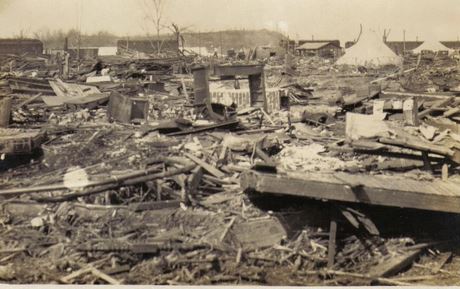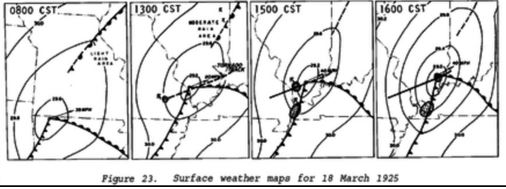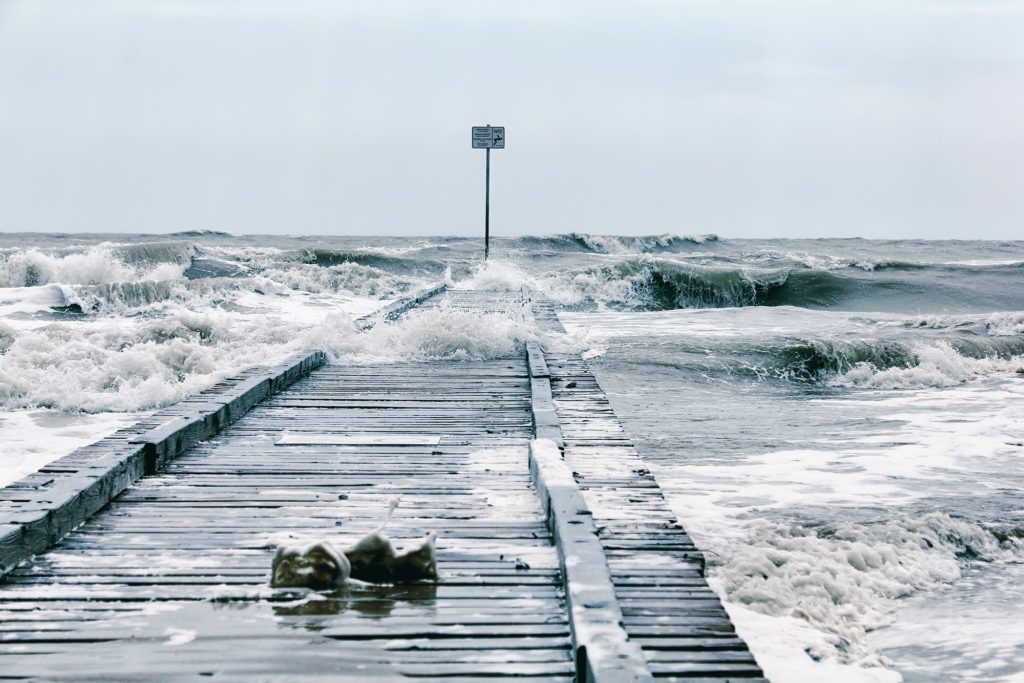On Wednesday, March 18, 1925, the deadliest and longest tracking tornado on record produced incredible devastation in three Midwestern states. Residents of those locations received no warning that a tornado was about to strike. When it was all over, six hundred and seventy-five people lost their lives and over fifteen thousand homes were destroyed. This incredibly deadly and destructive weather event became widely known as the ‘Tri-State Tornado”.
An Astonishing Weather Event
For residents of southeast Missouri and southern Illinois, the environment changed on the Wednesday morning of March 18, 1925. The temperature jumped up into the low 70s and the dew point surged to the low 60s.
The U.S. Weather Bureau in St. Louis had been tracking an area of low pressure that moved out of the Rockies to Oklahoma and then on to Missouri. There was an attending cold front with the storm and the warm front moved northward from the Gulf of Mexico. Since the temperature had risen suddenly in southern Missouri and southern Illinois, it was obvious that a warm front had passed through.
The official forecast from the U.S. Weather Bureau in St. Louis mentioned that there would be showers in the region, with shifting winds and then colder temperatures. The word tornado wasn’t mentioned because it was verboten at that time.
Back in 1887, the U.S. Army Signal Corps, which was in charge of weather forecasting, banned the word tornado from being used by weather forecasters. It was decided that since tornadoes couldn’t be predicted then any mention of the word could strike fear into the public. Forecasters were forbidden to study tornadoes to even mention them in a public forum.
By early afternoon, thunderstorms began to develop in the warm sector of the storm from Missouri to Kentucky and Tennessee. At 1 p.m. a thunderstorm cell began to rotate near ar Ellington, Missouri. At 1:01 p.m. a funnel cloud touched the ground and the misery began. The first fatality occurred when a local farmer was struck by a falling tree.
By 3:30 pm. when the tornado lifted and dissipated in southwest Indiana, six hundred and ninety-four more people perished from this atmospheric “monster”. Many thousands more were left homeless and destitute. Factories, businesses, and even schools were destroyed.
Here are some observations during that time frame :
Missouri
As mentioned, a tornado touched down near Ellington, Missouri at 1:01 p.m. The farmer that was killed was Sam Flowers, who was just released from prison.
At 1:15 p.m. the tornado struck Annapolis, Missouri, with incredible destructive fury. Ninety percent of the town was destroyed and four people were killed. Local residents indicated that the funnel was turning and twisting in different directions and was moving at a fantastic speed (actually it was moving at an astonishing 73 mph)!
A photo showing damage in Annapolis, Missouri following the Tri-State Tornado on March 18, 1925. Credit- Pinterest-Public Domain
Annapolis, Missouri, was one hundred percent destroyed and the neighboring town of Leadanna encountered twenty-five percent damage. Before crossing the Mississippi River into Illinois, the town of Biehle was totally destroyed. Residents there described two large funnels next to each other for over three miles. This indicated that the event included multiple tornadoes at times. All told, there were eleven fatalities in Missouri.
Illinois
Illinois took the brunt of this horrific tornado. It raced across the Mississippi River and into Illinois just after 2 p.m.
The first town in line was Gorham and its five hundred residents, where the tornado struck around 2:26 p.m. Initially, there was a thunderstorm that was dropping hail the size of golf balls. Shortly thereafter, residents described hearing a loud roar, much louder than any train. It was also described as a “pillar of black smoke about a mile wide.”
A photo showing damage from the Tri-State Tornado in Gorham, Illinois on March 18, 1925. Photo Credit-Pinterest-Public Domain.
Complete destruction was in progress. Parts of buildings, trees, clothing, and household appliances all filled the sky. Houses were blown off of their foundations and they were twisting all over the place. While a restaurant was collapsing and killing a cook, a cow was lifted into the air and dropped on the roof. There were thirty-seven fatalities in Gorham on that fateful day.
Next was Murphysboro, a railroad town with around twelve thousand residents, which was struck just after 2:30 p.m. Once again, there was a description of black clouds filled with debris, about a mile wide, racing along the ground. Houses were lifted and destroyed. The destruction included one hundred square blocks. A large fire the next day engulfed seventy more square blocks.
Unfortunately, the Longfellow Grade School took a direct hit and much of the building collapsed. An accounting of events is included in an article on popularmechanics.com.
At the Longfellow Grade School, children were rushing out of the building as it collapsed, trapping roughly half of the four hundred and fifty students. A block away, at the railroad repair yard, thirty-five men were killed as the tornado laid waste to their so-called shops.
According to Murphysboro resident Wallace Akin, many survivors rushed toward the school and began removing the rubble, “literally tearing their hands to the bone in their efforts.” Eleven died there and many more were hurt. Many of the seriously injured, including Akin’s father, were put aboard an emergency train that left for St. Louis three hours later.
A photo shows damage at West Frankfort, Illinois from the Tri-State Tornado on March 25, 1925. CreditPinterest-Pubic Domain.
Rescuers worked for days to clear rubble and look for survivors in Murphysboro. At a local school, a young survivor was pulled alive from the rubble two days late. Unfortunately, seventeen children were killed.
The overall death toll at Murphysboro was two hundred thirty-four and six hundred and twenty-three injuries. Many of the injured needed surgery to amputate limbs.
At 2:45 p.m. the tornado arrived at De Soto and was described as a churning black mass that was moving at a tremendous speed and about a mile and a half wide. Thirty percent of the town was destroyed.
The tornado only destroyed about twenty percent of the small mining own of West Frankfort. It was described as a very large wedge about a mile and a half wide and two smaller funnels near the main tornado. Miners came up from an underground shaft and saw the incredible damage.
A photo shows damage at West Frankfort, Illinois from the Tri-State Tornado on March 25, 1925. Photo Credit- Pinterest-Pubic Domain.
According to a publication in ustornadoes.com, a farmer found a barber chair from some other town, and a bond — that was in a safe, to begin with — was found one hundred and twenty-five miles away and later mailed back. A house was also left standing while the trees surrounding it were cut off at the trunk or uprooted. The death toll was high with one hundred and twenty-seven losing their lives and most of the fatalities were women and children.
As 4 p.m. approached, the tornado was ready to cross the border into Indiana and unleash more of its unbelievable fury. All told, six hundred and thirteen lost their lives in Illinois on that day!
Indiana
The first Indiana town across the border was Grifin where the tornado hit a little past 4 p.m. By that time, the tornado was moving at 73 mph. ! The town was 100 percent destroyed. Residents described one main tornado surrounded by three smaller ones. The death toll at Grifin was twenty-five and two hundred and two were injured.
At that time, the tornado changed direction just a bit (moving just north of due northeast). This put the town of Princeton on its path. The tornado struck before 4:20 p.m. Just prior to that, witnesses in rural areas close by reported mud and debris traveling at a tremendous speed with Many farms destroyed. In Princeton, the tornado destroyed twenty-five percent of the town and forty-five residents lost their lives.
Mercifully, this historic and devastating tornado lifted and disintegrated around 4:30 pm.
Fast Facts
Here are some incredible statistics about the Tri-State Tornado complied by www.tornadofacts.net.
- The Tri-State Tornado occurred on Wednesday, March 18th, 1925.
- The damage was estimated at $16.5M and in 2011 adjusted dollars that is approximately $1.4B.
- Three states were affected by the Tri-State Tornado: Illinois, Indiana, and Missouri.
- Thirteen counties in three states were affected. In Illinois Franklin, Hamilton, Jackson, White, and Williamson counties were affected. In Indiana Gibson, Pike, and Posey counties were affected. In Missouri Bollinger, Iron, Madison, Perry, and Reynolds counties were affected.
- The path of the Tri-State Tornado was 235 miles with an average width of 3600 feet, however, there were moments when the width reached over 1 mile wide.
- The Tri-State Tornado lasted for 3 1/2 hours, starting down at 1:01 pm 3 miles NNW of Ellington, MO, and dissipating at 4:30 pm 3 miles SW of Petersburg, IN.
- The average forward speed of this tornado was 62 miles per hour with a record-setting speed of 73 miles per hour at one point.
- The Tri-State Tornado was an F5 on the Fujita Scale with winds reaching nearly 300 miles per hour.
Tri-State Tornado Records
- The deadliest tornado in U.S. history with 695 deaths; twice as high as the 2nd deadliest tornado.
- The 2nd deadliest tornado in world history.
- The deadliest tornado in Illinois history with 613 deaths.
- The deadliest tornado in Indiana’s history with 71 deaths.
- The 5th costliest tornado in U.S. history (1925 dollars)
- The longest-lasting tornado in world history.
- The greatest distance traveled for a tornado in world history.
- The longest damage path for a tornado at 151 to 235 miles. The highest forward speed is at 73 miles per hour.
Meteorological Conditions
The surface weather map for that day showed an area of low pressure moving northeastward from Missouri into Illinois with attending warm and cold fronts. It appears that the low pressure occluded in southeast Missouri (cold front catches the warm front) creating a “triple point” where there is plenty of turning in the atmosphere with height (helicity). We know that there was strong warm advection prior to the event with temperatures in the low 70s and dew points in the low 60s.
A very strong low -level was also in place just above the surface as winds veered with height so the wind shear would have been in place, In fact, those recreating this event estimate that there were helicity values of 340 m2 s−2 in the vicinity of the Tri-State supercell track (that is very high).
The event probably consisted of a number of tornadoes, rather than just one single tornado, and we know that at times there were multiple vortices. What’s almost beyond belief is how extensive the F5 tornado damage was. Before the Fajita scale was updated, F5 winds ranged from 26 to 318 mph.
There were other tornadoes that day, from the Ohio Valley to Tennessee which resulted in 52 more fatalities and 271 injuries.
A surface weather map sequence on the day of the Tri-State Tornado (March 18, 2015). Map Credit- U.S. Weather Bureau.
A very strong low -level was also in place just above the surface as winds veered with height so the wind shear would have been in place, In fact, those recreating this event estimate that there were helicity values of 340 m2 s−2 in the vicinity of the Tri-State supercell track (that is very high).
The event probably consisted of a number of tornadoes, rather than just one single tornado, and we know that at times there were multiple vortices. What’s almost beyond belief is how extensive the F5 tornado damage was. Before the Fajita scale was updated, F5 winds ranged from 26 to 318 mph.
There were other tornadoes that day, from the Ohio Valley to Tennessee which resulted in fifty-two more fatalities and two hundred and seventy-one injuries.
Aftermath
There were no federal programs or declarations of disaster areas at that time. many farmers lost their land and businesses were wiped out. It was difficult to get enough money to rebuild and then there were incredible medical hardships.
Here is a description of the terrible aftermath of the St. Louis Post-Dispatch.
” Scenes of suffering and horror marked the storm and re. Throughout the night relief workers and ambulances endeavored to make their way through the streets strewn with wreckage, fallen telegraph poles and wires, and burning embers. The only light afforded was that of the burning area.”
“The cost was $17 billion to repair the tornado’s destruction.”
A tornado spotting system was soon developed to help with the communication of tornado information to the public, in tandem with radio stations. It really wasn’t until after World War Two that a more serious effort was made to understand and predict tornadoes.
Scientific advances like Dopper Radar and satellite photos have helped in this endeavor. Also, new computer models can help meteorologists to pinpoint areas where tornadoes may occur on a given day and even several days into the future.
An image showing modern-day Doppler Radar showing a thunderstorm cell with a likely tornado in Wisconsin. Image Credit- NOAA.
I can only imagine the environmental effects that a storm of this nature can impose, but I’ll leave that topic for another time. Hopefully, we will never have to experience anything like the Tri-State Tornado again.








